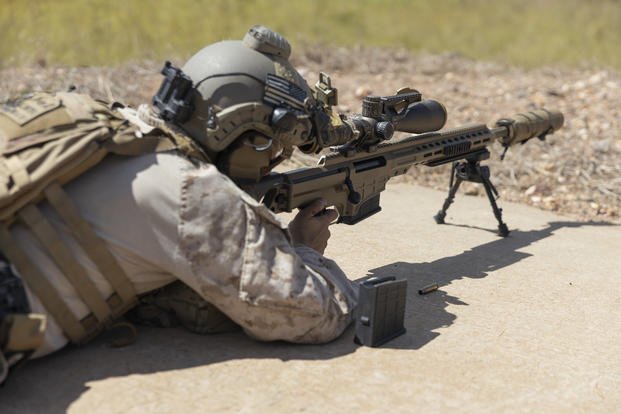The Marine Corps’ newest sniper rifle is ready for prime time.
Marine Corps Systems Command announced Tuesday that it has reached full operational capability for the service’s new Mark 22 Advanced Sniper Rifle, which means that all infantry and reconnaissance units have fielded and completed new equipment training on the system.
The rifle is based on the Barrett Firearms’ Multi-role Adaptive Design bolt-action sniper rifle and is capable of chambering 7.62×51 mm NATO, .300 Norma Magnum, and .338 Norma Magnum rounds, among others, through a relatively simple barrel conversion process. The Marine Corps officially adopted the Mk22 in 2020 to replace the M40A6 and Mk13 Mod 7 sniper rifles in its arsenal.
Read Next: Police Report Sheds New Light on Pentagon Nominee Hegseth’s Sexual Encounter that Led to Assault Allegation
The system consists of the rifle itself, three barrels, a 7×35 variable power optic designated the M317 Precision Day Optic, and a suppressor, according to Marine Corps Systems Command. Infantry and recon units also received an additional .300 Winchester Magnum barrel, a scout sniper tripod kit, and a laser filter unit.
The command said the rifle was deemed fully operational a year ahead of schedule.
With an effective range of up to 1,500 meters, the Mk22 can reach targets well beyond the M40’s 1,000-meter range and the Mk 13 Mod 7’s 1,300-meter range, albeit in a heavier package. But the most appealing feature of the Mk22 is its modularity: The barrel conversion process eliminates the need to carry separate weapons chambered in different calibers for different mission requirements, which not only offers Marines more flexibility but reduces logistics and maintenance burdens.
“Marines like the ability to conduct caliber conversions at their level and the fact that they only have one rifle instead of the two it replaced,” Kevin Marion, a Marine Corps Systems Command logistics management specialist, said in the Tuesday statement. “This shift improves operational efficiency, reduces the logistical burden on units, and lightens the individual Marine’s load.”
“[Replacing a barrel] was impossible with previous systems, where a condemned barrel would render the weapon unusable, directly affecting mission readiness,” added Mk22 project manager Brian Nelson. “Now, the Mk22 ensures that, even if a barrel fails, Marines are still mission-ready.”
The road to Marine arsenals has been a long one for the Mk22.
It was originally developed for U.S. Special Operations Command’s Precision Sniper Rifle program in late 2009 and initially snubbed in favor of Remington Arms’ Mk21 Modular Sniper Rifle. SOCOM awarded a $49.9 million contract to Barrett in 2019 to adopt its Multi-role Adaptive Design, or MRAD, under the Advanced Sniper Rifle program, with both the Army and Marine Corps pushing to adopt the modular rifle in their fiscal 2021 budget requests.
Between 2021 and 2023, the Marine Corps purchased 587 Mk22 rifles for roughly $6.73 million, according to the service’s fiscal 2024 budget request.
The full adoption of the Mk22 comes amid a Pentagon push to address a sniper gap with near-peer adversaries like Russia and China. Beyond the MRAD, the Army and Marine Corps have in recent years both raced to adopt not only new sniper rifles like the Mk 22 and the Mk 13 Mod 7, but new designated marksman rifles like the the M110A1 Squad Designated Marksman Rifle and M38 variant of the M27 Infantry Automatic Rifle.
In January, SOCOM released a market research notice regarding an “Extreme Long Range-Sniper Rifle” capable of delivering effective fire at ranges of up to 2,500 meters as a successor to the Barrett M107, although that search was halted in October.
Related: US Military Searching for New Long-Range Sniper Rifle in Bid to Keep Edge over Russia and China
Story Continues
Read the full article here

